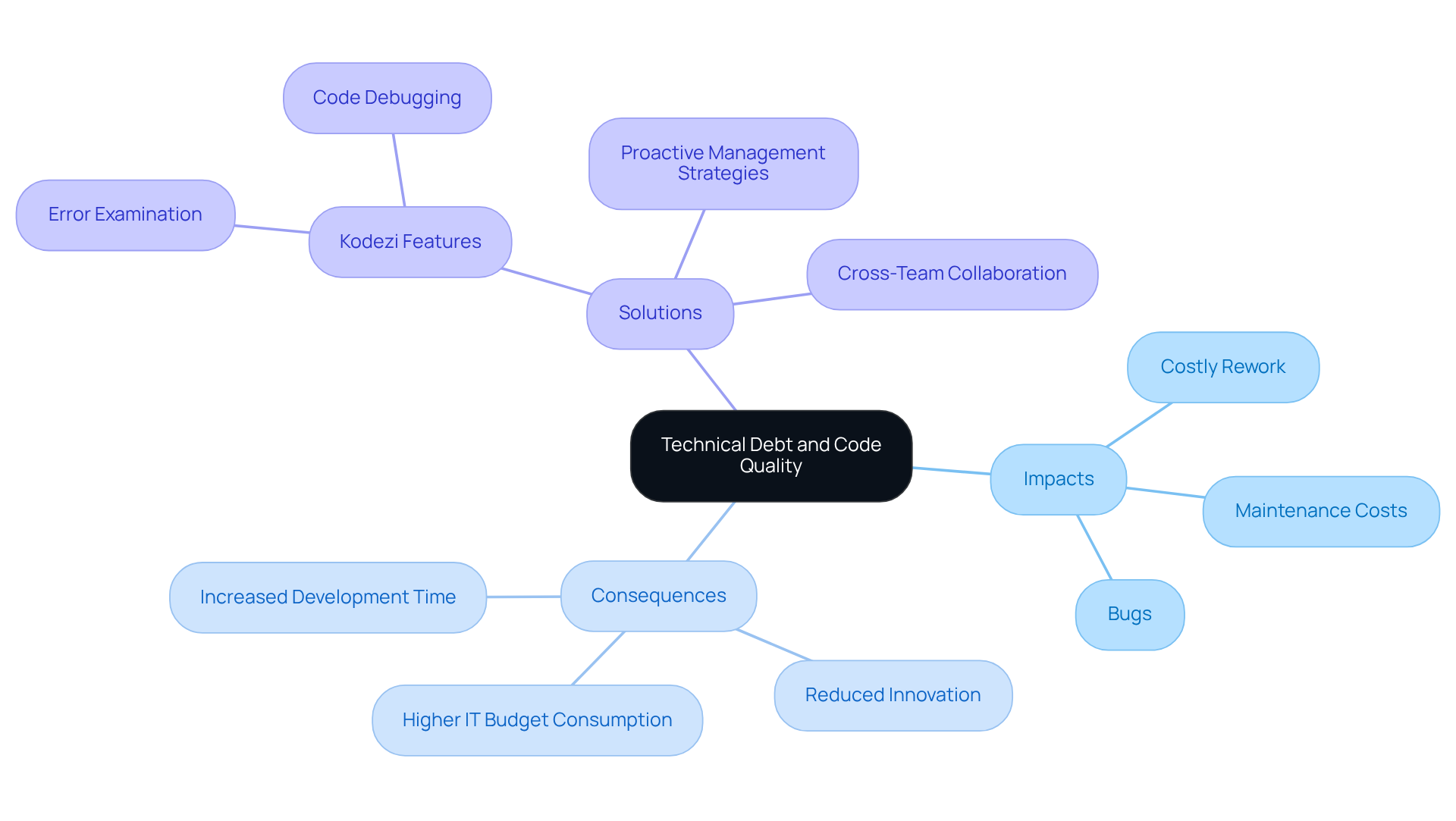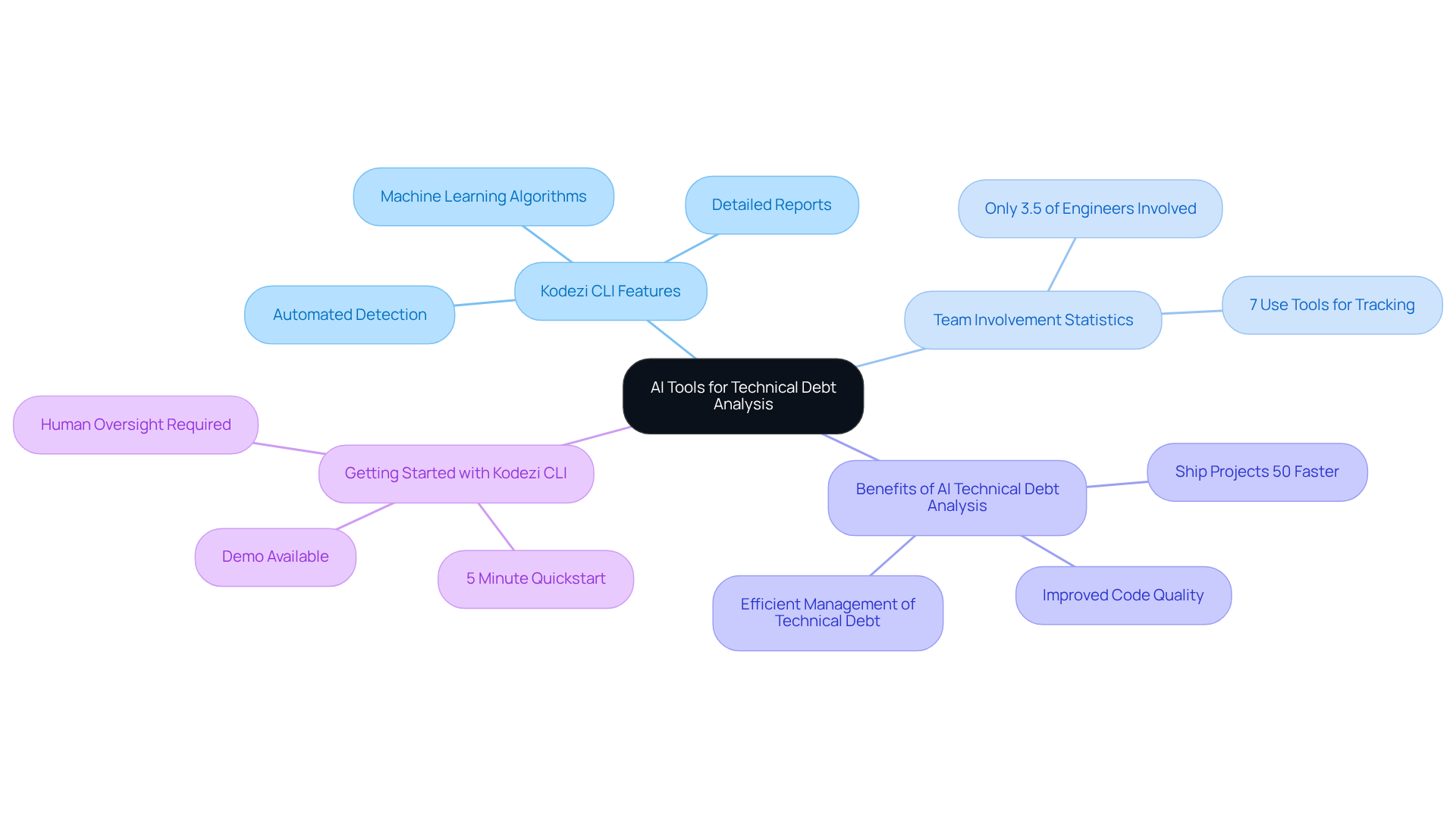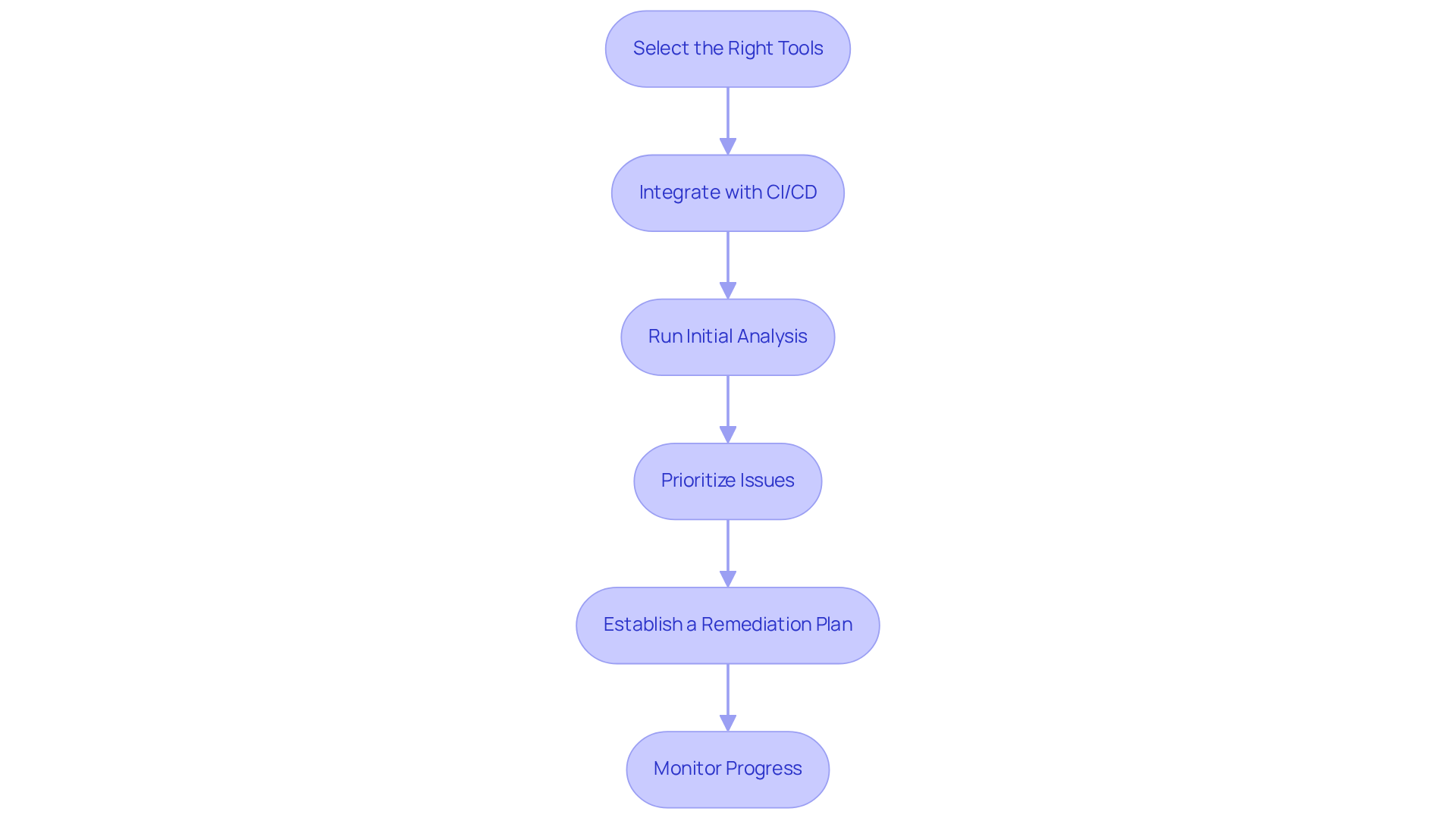Introduction
The challenges of modern software development often push teams to implement quick fixes, leading to a hidden burden known as technical debt. This issue can severely impact code quality, resulting in costly rework and sluggish development cycles. What if there was a way to not only identify these issues but also implement solutions that foster a more efficient and innovative development process?
Enter Kodezi, a platform designed to tackle these coding challenges head-on. With features that streamline workflows and enhance coding practices, Kodezi empowers developers to address technical debt effectively. By leveraging its tools, teams can uncover opportunities to improve their coding standards and boost overall productivity.
Imagine the benefits:
- Improved code quality
- Faster development cycles
- A more collaborative environment
Kodezi not only helps identify technical debt but also provides actionable insights that lead to tangible improvements.
Are you ready to transform your coding practices? Explore the tools available on Kodezi and discover how they can elevate your development process.
Define Technical Debt and Its Impact on Code Quality
AI technical debt analysis highlights that technical debt presents a significant challenge for developers, often leading to costly rework down the line. When teams opt for quick fixes or suboptimal solutions during software development, they may inadvertently create challenges that require AI technical debt analysis, manifesting as outdated libraries, poorly organized code, or insufficient documentation. These shortcuts can escalate maintenance costs, slow down development cycles, and increase the likelihood of bugs, necessitating careful AI technical debt analysis.
Have you ever found yourself spending more time fixing issues than developing new features? This is a common scenario for teams that prioritize speed over quality, ultimately stifling their ability to innovate and complicating their AI technical debt analysis. Fortunately, tools like Kodezi can help address these challenges effectively.
Kodezi stands out by automatically examining errors and offering fixes, acting as an autocorrect for code. Unlike other tools such as Copilot, which primarily focus on code completion, Kodezi allows users to debug and resolve coding issues efficiently. With its AI-driven features supporting over 30 programming languages and integration with Visual Studio Code, Kodezi empowers teams to detect and tackle coding problems more effectively.
By leveraging Kodezi, teams can significantly reduce long-term expenses related to AI technical debt analysis and code quality issues. Identifying indicators of code problems early on and utilizing Kodezi's features can support AI technical debt analysis to help maintain a healthier codebase.
In addition, consider the benefits of improved productivity and code quality that Kodezi offers. Why not explore the tools available on the platform and see how they can enhance your coding practices?

Utilize AI Tools for Comprehensive Technical Debt Analysis
Coding challenges can be a significant hurdle for developers. How often do you find yourself grappling with AI technical debt analysis? This is where Kodezi CLI comes into play. As an AI-driven tool, it independently enhances code quality and resolves issues before they reach production.
Kodezi CLI is designed to boost programming efficiency by automating the detection of software smells, vulnerabilities, and inefficiencies. It scans your codebase and provides detailed reports on areas that need attention. By employing machine learning algorithms, it identifies patterns and predicts potential issues based on historical data. For example, it might flag a function that frequently changes as a candidate for refactoring, allowing teams to proactively address high-risk areas.
Incorporating Kodezi CLI into your CI/CD pipeline means you can consistently monitor code quality and tackle issues as they arise. Did you know that only 3.5% of engineers report complete team involvement in managing technical debt? This statistic highlights the challenges many teams face in effectively handling AI technical debt analysis. Moreover, AI technical debt analysis can lead to managing technical debt efficiently, resulting in shipping projects 50% faster and showcasing the tangible benefits of a proactive approach.
To get started quickly, teams can refer to the '5 minute quickstart' and check out a demo to see how Kodezi CLI can enhance their workflow. However, it’s crucial to maintain human oversight when using AI tools like Kodezi CLI. This ensures that the insights provided align with your team's expertise and project objectives.

Implement Step-by-Step AI Analysis Techniques for Your Codebase
Coding challenges can be daunting for developers, often leading to frustration and inefficiencies. But what if there was a way to tackle these issues head-on? Enter Kodezi, a powerful tool designed specifically for B2B engineering teams. With features that enhance programming skills and improve code quality, Kodezi helps fix bugs before they reach production, ensuring a smoother development process.
To effectively implement AI analysis techniques for your codebase, follow these structured steps:
-
Select the Right Tools: Choose AI tools that align with your technology stack and group needs. Common choices include SonarQube for static analysis, which assists in detecting design smells and vulnerabilities, and CodeClimate for performance monitoring, offering insights into maintainability. Furthermore, Kodezi stands out as an independent solution tailored specifically for B2B engineering groups.
-
Integrate with CI/CD: Ensure that your selected tools are seamlessly integrated into your CI/CD pipeline. This integration enables ongoing surveillance and prompt feedback on software quality, allowing teams to tackle problems as they occur.
-
Run Initial Analysis: Perform a baseline examination of your codebase to reveal current issues. Focus on key metrics such as code complexity, duplication, and test coverage, which are critical indicators of code health. Ignoring these can lead to higher operational expenses and stifle innovation.
-
Prioritize Issues: Utilize the insights gained from the AI technical debt analysis to prioritize remediation efforts for technical debt. Concentrate on high-impact areas that could greatly improve software quality and boost team productivity. For instance, addressing the most intricate parts of the program first can lead to significant enhancements in maintainability.
-
Establish a Remediation Plan: Develop a comprehensive plan to tackle the identified issues. This plan should include strategies for refactoring, updating documentation, and enhancing testing practices to ensure long-term code quality.
-
Monitor Progress: Consistently repeat analyses to observe enhancements and prevent the buildup of new issues. Adjust your strategies based on the findings to maintain a clean and efficient codebase. High-achieving groups often dedicate 10-20% of their development time to managing coding issues, resulting in improved overall performance and customer satisfaction.
By leveraging Kodezi and following these steps, you can enhance your coding practices, leading to better productivity and code quality. Why not explore the tools available on the platform today?

Troubleshoot Common Issues in AI Technical Debt Analysis
When it comes to AI technical debt analysis, developers often face significant challenges. False positives are a common issue with AI tools, which can flag non-issues as technical debt, leading to unnecessary distractions. Studies show that static analysis tools can produce a staggering number of false positives, with some reports indicating rates as high as 30%. To combat this, it's crucial to regularly assess and adjust the tool's sensitivity settings to align with your team's coding standards. As Bernard Marr points out, managing false positives is vital for maintaining trust in AI tools.
Integration challenges also pose a hurdle. Integrating AI tools into existing workflows can be complex, so it's essential that your team receives adequate training and has access to thorough documentation. Tools like Parasoft can help manage results effectively, assisting teams in overcoming these integration obstacles.
Another concern is data overload. AI tools can churn out vast amounts of data, making it tough to extract actionable insights. Focus on key metrics that align with your team's objectives, such as the debt-to-code ratio and module instability index, while prioritizing AI technical debt analysis to avoid being overwhelmed by irrelevant information.
Moreover, there's often resistance to change. Team members may hesitate to adopt AI tools due to unfamiliarity or skepticism. Fostering a culture of continuous improvement is essential; showcase the benefits of these tools through successful case studies, particularly those that illustrate the balance between false positives and false negatives in static code analysis. Encourage open discussions about their implementation to ease concerns.
Lastly, the absence of follow-up can hinder progress. After identifying issues, teams may neglect to act on their findings. Establishing a regular review process is key to ensuring that the AI technical debt analysis identifies and addresses issues promptly. Integrate this into your sprint planning to maintain momentum in tackling technical debt.

Conclusion
AI technical debt poses a significant challenge for developers, affecting both code quality and project efficiency. Are you aware of how this issue can impact your workflow? Recognizing the implications of technical debt and managing it effectively through AI-driven tools like Kodezi can greatly enhance your team's ability to maintain a healthy codebase and foster innovation. By prioritizing quality over quick fixes, teams can steer clear of escalating maintenance costs and sluggish development cycles.
Kodezi stands out by automating the identification of code issues and providing actionable insights. This article highlights the importance of utilizing AI tools for comprehensive technical debt analysis. Key steps include:
- Selecting the right tools
- Integrating them into CI/CD pipelines
- Establishing a systematic approach to monitor and remediate technical debt
Furthermore, addressing common challenges such as false positives and data overload is essential for maximizing the effectiveness of these tools.
Ultimately, embracing AI for technical debt analysis is more than just adopting new technology; it’s a strategic move toward enhancing productivity and ensuring long-term code quality. By fostering a culture of continuous improvement and leveraging insights gained from AI tools, teams can navigate the complexities of software development more effectively.
Now is the time to explore the available resources and integrate these practices into your workflow. Don’t let technical debt loom over your development process; make it a manageable aspect of your work.
Frequently Asked Questions
What is technical debt?
Technical debt refers to the challenges and costs associated with quick fixes or suboptimal solutions in software development, which can lead to issues such as outdated libraries, poorly organized code, and insufficient documentation.
How does technical debt impact code quality?
Technical debt can escalate maintenance costs, slow down development cycles, and increase the likelihood of bugs, ultimately leading to a decline in code quality and hindering innovation.
What common scenario do teams face due to technical debt?
Teams often find themselves spending more time fixing issues than developing new features, especially when they prioritize speed over quality.
What tools can help manage technical debt?
Tools like Kodezi can help address technical debt challenges by automatically examining errors and offering fixes, acting as an autocorrect for code.
How does Kodezi differ from other coding tools?
Unlike tools such as Copilot, which focus mainly on code completion, Kodezi allows users to debug and resolve coding issues more efficiently, supporting over 30 programming languages and integrating with Visual Studio Code.
What are the benefits of using Kodezi?
Kodezi helps teams reduce long-term expenses related to technical debt and code quality issues, improves productivity, and enhances overall code quality by identifying indicators of code problems early on.




